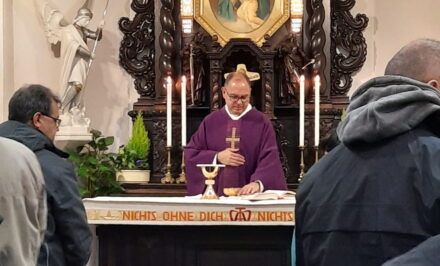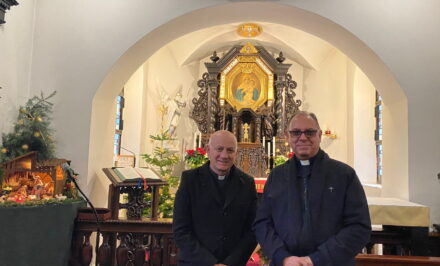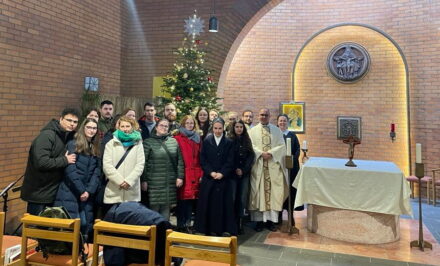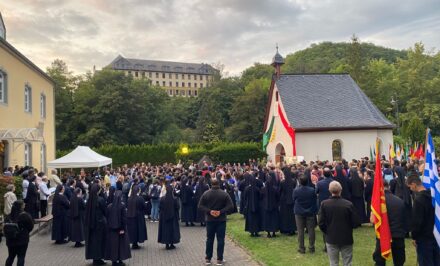 Agathe Hug. In February we had a look at the interior of the Original Shrine – the floor, walls, heating. The month of March invites us to take a look at the statues in the Original Shrine. It is logical that on 19 March the statue of St Joseph is the centre of attention.
Agathe Hug. In February we had a look at the interior of the Original Shrine – the floor, walls, heating. The month of March invites us to take a look at the statues in the Original Shrine. It is logical that on 19 March the statue of St Joseph is the centre of attention.
19 March 1927
The Sisters of Mary placed a statue of St Joseph on the left corner cupboard. St Aloysius was transferred to the right corner cupboard and the statue of St John Berchman was removed. It is unclear where it was taken.
(By the way, have you ever asked how St Aloysius got into the Founding Document? Like Pontius Pilate into the Credo? No. In the Founding Document Fr Kentenich spoke about a second patron, St Aloysius. In the Jesuit tradition Aloysius became the patron of Marian Sodalities. He was part of their pedagogical system. There were Aloysius Sundays in June and July. These were the six Sundays following 21 June, which were celebrated in different ways – with sermons, confession, Communion, etc. for the youth.
Aloysius, the son of a nobleman, became the example for young people because he entered the Jesuits at the age of 17 and died of the plague in Rome at the age of 23. He was beatified 14 years after his death, on 19 October 1605 by Pope Paul V. On 31 December 1726, together with another Jesuit Novice, Stanislaw Kostka, he was canonised by Pope Benedict XIII. In 1729 he was declared the patron of young students by the same Pope. In 1926 he was declared patron of Christian youth by Pope Pius XI. He was the patron of victims of the plague and is today also the patron of people with AIDS.)
A year after the beatification of Vincent Pallotti (22 January 1950), the statue of St Aloysius was replaced by a Pallotti group (21 January 1951). Its symbolism never really appealed, because it can mislead those who look at it by giving Pallotti a function he never had in history with regard to the shrine. At about the same time a Sister of Mary had created another Pallotti statue, but it was never used in the Original Shrine. It was this statue Fr Kentenich had in mind in 1949 when he recorded a message in South America in which he announced that a Pallotti group would replace the statue of St Aloysius, since this statue would have done more justice to the tradition of new Schoenstatt.
19 March 1953
On the feast of St Joseph the Pallottine Brothers put up a statue of St Joseph as the Guardian of the Church. It replaced the original statue of St Joseph, which was taken to Mount Schoenstatt by the Sisters of Mary and later put into their shrine there.
25 March / 9 April 1934
 The new altar (with two adoring angels and a new wooden crown for our Lady), and the new Communion rails, were put up in the shrine. Old photos show that originally the MTA picture hung directly on the wall in the sanctuary.
The new altar (with two adoring angels and a new wooden crown for our Lady), and the new Communion rails, were put up in the shrine. Old photos show that originally the MTA picture hung directly on the wall in the sanctuary.
The 9 April is important, because the Pallottine Provincial Superior, Fr Baumann, consecrated the chapel on 9 April 1934 under the title of Mary’s Motherhood. Its patronal feast became 11 October, so that each year there was a solemn octave from 11-18 October. (Originally the feast of the Annunciation, 25 March, had been planned for the consecration, but since it fell on Palm Sunday in 1934 it had to be transferred to the Monday following Low Sunday.) There are two reports on the consecration:
In January 1935, hence almost a year after the new altar had been put up in the Original Shrine, Fr Kentenich said that the interior of the shrine could not cope with further changes if it was to retain its typical character for all time. However, one more change was made on 12 November 1935 when the two angels of adoration on either side of the tabernacle were replaced by the Princes of the Apostles, Sts Peter and Paul, while the wooden crown was replaced by a gilded one. We could ask: Why were the angels replaced so rapidly, and why by the apostles? You can find the answer on the following website pages:
In 1963 Fr Kentenich was asked in Milwaukee about his opinion: What did he regard as unchangeable in the shrine, and what could be changed? In his reply he pointed to the value of the psychological impression created by the shrine. For this reason he said that the sanctuary and altar in daughter shrines should be replicas of the Original Shrine, in fact so similar that they could be mistaken for each other. Beyond this local wishes and interests could be met as far as possible. This directive has been followed till today in all central shrines.
March 1951
The chimney of the Original Shrine, which was no longer in use because of the new central heating, was removed.
27 March 1961
Fr Fellner blessed the new doors to the shrine, which had been donated and sacrificed for by the League for the Sick. The old doors had opened into the shrine, the new ones open outwards.
21 March 1932
One of the two towers collapsed on Monday in Holy Week. A report can be found on:

Photos:
1. The shrine 1934. The new altar is erected. The two adoring angels can be seen on the photo.
The altar builder had recognised that the ancient kneeler had been part of a baroque altar, and incorporated it into the new altar. Since the carved portion of the former kneeler had also been used as a communion rail, and was exactly as high as the tabernacle, it was used as a background and framework of the tabernacle.
2. The shrine on 19 March 1927. The Sisters of Mary give a statue of St Joseph to the Original Shrine. He was asked to help them in their financial needs.
3. Collapse of the “Old Tower” on 21 March 1932, the one on the left. The photo was taken five minutes afterwards.
Source: www.urheiligtum.de
Translation: Mary Cole, Manchester, England













